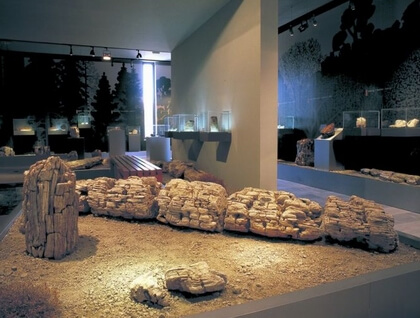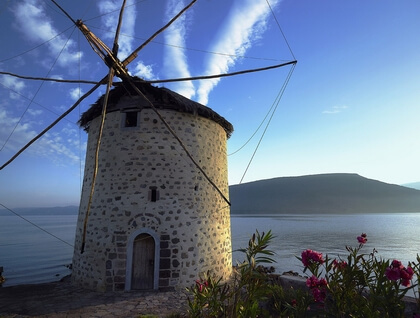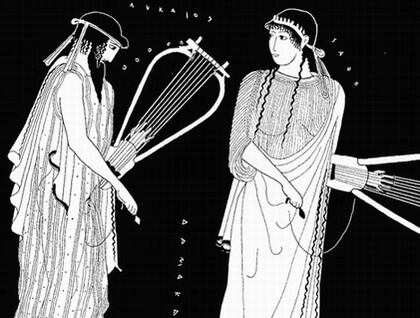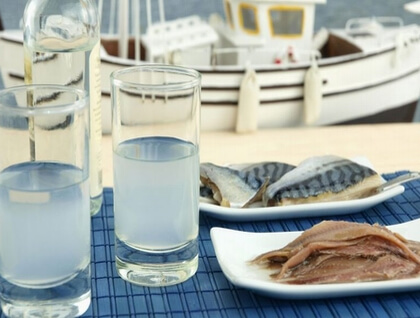SIGHTS

Museum of natural history
The Museum of the Lesvos Petrified Forest was established in 1994 in order to study, research, promote, preserve and protect this invaluable "testimonial" of life in the distant past. In 2001, the museum was awarded the Eurosite Management Award for its effective management of the Lesvos Petrified Forest. In February of 2004, the Petrified Forest of Lesvos was inducted into the Global Geopark Network of UNESCO.
The Petrified Forest of Lesvos is one of the most fascinating and rare monuments of geological heritage in the world. Its creation, 20.000 000 year ago is connected with the intense volcanic activity in the Aegean during the Miocene period. In 1985, the forest was declared a Protected Natural Monument.
The Museum, a single storey building made of the grey lava stones which abound in the region, covers a total area of 1.597 sq.m. The interior spaces within the museum, diffused with natural light from the glass roofs and windows, are organized around a central courtyard in which impressive fossilized trunks side by side with their present day counterparts wonderfully depict the flora of the Aegean 20 million years ago.
(source: lesvosmuseum.gr)

Museum of Theofilos's paintings
The Theophilos Museum was built in 1964 in Varia, a suburb of Mytilene, where the popular artist was born and spent his childhood years. It was built by the famous Mytilenian publisher of art books in Paris, Stratis Eleftheriades (Teriade).
In 1965, Teriade donated the Museum to the Municipality of Mytilene, together with 86 of Theophilos' paintings from his own private collection. Since then, it has been operating as a municipal museum.
The building is built in the dusty pink local stone, which harmonizes prefectly with the extensive olive grove around it. It consists of four connecting rooms in which are displayed 86 paintings by Theophilos. Their subjects are inspired from folk art, history and mythology. They also depict everyday scenes, costumes, landscapes, etc.
(source: odysseus.culture.gr)

Museum of industrial olive-oil production
The Museum of Industrial Olive-Oil Production in Lesvos is housed in the premises of the old communal oil-mill. The project has been included in the 2000-2006 North Aegean Regional Operational Programme and has been financed by the Third EU Structural and Cohesion Fund. This Museum is part of a network of thematic museums of technology created by the Foundation and is a natural extention of the Museum of the Olive and Greek Olive Oil in Sparta.
The Agia Paraskevi complex has been developed as “an oil-mill turned into a museum of an oil-mill”, restoring both its architectural and mechanical features to their original condition. The old machinery and equipment that have been preserved, and fully restored, are being exhibited in a unique way by being put into use for demonstration’s sake, which is supported by digital shows.
One can witness the development of the various machines, while special emphasis is given to the changes the introduction of mechanical power brought into the process of oil-production. In the main building the three basic steps of the oil-production process (crushing the olives, pressing the olive-pulp, separating oil from water) are shown, while reference is made to the auxiliary operation of the flour-mill. The former storage areas of the olive crop are used as auxiliary exhibition halls, in which exhibits present the human element involved in oil production.
(source: oliveoilmuseums.gr)

Archaiological museum
The Old Building of the Archaeological Museum of Mytilene is unfolding the history of Lesvos from the Final Neolithic period to the late Roman Empire. A few minutes from there is the New Archaeological Museum Building.
The new building was constructed according to the latest museological concepts. Construction work was completed in 1995. With the exhibition at the new building of the Archaeological Museum of Mytilene is unfolding the everyday religious, economic and political life of the 3rd century. BC until the 4th c. A.D.
It is divided into three levels. In the three consecutive spaces on the ground floor were mosaic floors of Roman villas, while in the semi-basement were placed samples of sculpture of Lesvos (reliefs, portraits, holograms). In the halls of the periodic exhibition, exhibits are hosted on Roman symposia. The mosaic floors of a Roman villa of the 3rd c. AD, with the conventional name "Menandros House", which was the seat of an association of people in the theater.
(source: odysseus.culture.gr)
ABOUT Mytilene ISLAND
HISTORY
The prehistoric city of Thermi (ca 3000 BC), the ancient Greek temple of Messa, the aqueduct and the mosaics of the roman period, the byzantine churches, the castles of the medieval period, the mosques of the Ottoman time, the industrial heritage of the past century including olive press and olive oil processing installations, the traditional architectural style of the buildings and the small villages form a unique colorful cultural atmosphere offering an unforgettable experience to the visitors.
explore
GEOGRAPHY
Mytilene (Μυτιλήνη in greek, also known as Mytilini) is the capital of the island of Lesvos. It is the third bigger island of the Aegean Sea.
explore
FAMOUS MYTILENEANS
The island has a long cultural tradition from the ages of the ancient Greek music composer Terpandros, the poets Sappho and Alkaeos, the one of Greece's Seven Sages Pittacos and the philosopher Theophrastos up to the contemporary naive painter Theofilos and the 1997 Nobel prize winner poet Odisseas Elytis.
explore
FAMOUS PRODUCTS
Today the island is famous for the excellent olive oil produced from the 11.000.000 olive trees. Ouzo is another characteristic product of the island which affects the local food culture and tradition.
explore
SIGHTS
On Lesvos island in parallel to the life culture there are many museums and archaeological sites of high interest like:
- The museum of natural History located in the area of the petrified forest.
- The two archaeological museums in the city of Mytilini
- The three major castles in Mytilini, Mythimna and Sigri
- The unique collection of the Theofilos paintings and the modern paintings collection of Terriade in the outskirts of Mytilini.
- The industrial museum of olive oil production in Aghia Paraskevi.
- The olive press Museum in Papados etc


 This website respects your privacy and is GDPR compliant. No cookies are used.
This website respects your privacy and is GDPR compliant. No cookies are used.